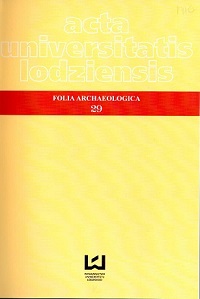Elementy uzbrojenia na kaflach renesansowych z założeń dworskich w Kozłowie
DOI:
https://doi.org/10.18778/0208-6034.29.15Słowa kluczowe:
kafle płytowe, uzbrojenie, ikonografia, nowożytnośćAbstrakt
During archaeological excavations conducted on the site of the relics of manor houses in Kozłów, Silesia province, an impressive set of stove tiles has been discovered. Some of the tiles’ facings were decorated with representations that are interesting iconographic sources for the study of early medieval arms.
The first tile was discovered in the remains of the manor from the late 15th and 16th c. Facing of this tile is decorated with a side profile of the rider’s head in a closed helmet with a crest. Visual presentation is not so detailed and not all the details of surface texture are sharp. The portrayed helmet is probably a tournament example called the frog face helm. Its bell is crowned with an extensive crest, which is an oval with short and long feathers modeled in different directions. At the back of the bell there are ribbon like mantlings visible. Due to the lack of large part of the tile it is difficult to determine whether the visible crested helm was a part of a heraldic motif or whether it was connected with representations of knightly culture such as tournament scenes for example. The first possibility seems more likely.
The second tile was found in layers associated with the manor which functioned in the 16th century. The presentation on the facing of tile refers to a series of woodcuttings created by the German renaissance painter Georg Pencz, gathered under one title of Twelve Heroes of the Old Testament. These works were inspired by the text of the poem by Hans Sachs from 1531. The author was glorifying the heroic exploits of the twelve heroes from the Old Testament: Joshua, Gideon, Jephthah, Samson, Jonathan, David, Abia, Azah, Josaphat, Amazia, Hezekiah and Judas Maccabeus, portraying them as symbols of the defenders of Christianity. Facing of the tile from Kozłów is ornamented with the image of Juda’s king Amazia. Similar to a Pencz’s graphic, he has been presented in an armour with his head and torso slightly turned to the left. The whole scene was made with high attention to the details, which allows us to make some valuable observations on the components of the armour. The helm is a close helmet with bevor and gorget, depicted with a lifted visor. The torso is protected with a bulging breastplate with fauld attached below. The arm is covered with a massive overlapping breastplate pauldrons and bulging rerebrace. In the lower part, at the height of faulds, there is a visible fragment of a sword hilt, one and a half or two-handed, topped with an oval pommel. A similar suit of armour, often called Maximilian armour, was used in Europe since the 1630s. Armour of this type was popular at that time in Silesia as well, what is indicated by the numerous tombstone representations.
Pobrania
Bibliografia
Blair C. 1958 European Armour: Circa 1066 to Circa 1700, London.
Google Scholar
Brych V. 2004 Kachle doby gotické, renesanční a raně barokní, Praha.
Google Scholar
Cieśla M. 2008 Broń renesansowa na Śląsku, Racibórz.
Google Scholar
Durdík T., Hazlbauer Z. 1993 Každodenní život. Gotické a renesanční kachle východního křídla předzámčí v Kostelci nad Černými Lesy, „Castellologica Bohemica” 3, s. 289–314.
Google Scholar
Dąbrowska M. 1987 Kafle i piece kaflowe w Polsce do końca XVIII wieku, Wrocław–Warszawa–Kraków–Gdańsk–Łódź.
Google Scholar
Dymek K. 1995 Średniowieczne i renesansowe kafle śląskie, Wrocław.
Google Scholar
Geisberg M. 1923 Der deutsche einblatt Holzschnitt in der ersten Hälfte des XVI. Jahrhunderts, I, München.
Google Scholar
K.B. 1916 Die Ehrenpforte der zwölf sieghaften Helden des Alten Testaments, „Ost und West”, Jg. 16, H. 2/3, s. 113–116.
Google Scholar
Kováčik P., Veselá P. 2009 Stove tiles from Starý Bohumin, „Studies in Post Medieval Archeology” 3, s. 289–302.
Google Scholar
Loskotová I. 2012 Brněnské kachle se starozákonními hrdiny, „Archeologia Historica” 37/2, s. 663–678.
Google Scholar
Majewski M. 2010 Wstępne wyniki interwencyjnych badań archeologicznych przy ul. Ratuszowej w Reczu, pow. choszczeński, „Zachodniopomorskie Wiadomości Konserwatorskie”, R. IV/2010, s. 109–120.
Google Scholar
Menoušková D., Loskotová I., Čeněk P., Vitanovský M. 2008 Krása, která hřeje: výběrový katalog gotických a renesančních kachlů Moravy a Slezska, Uherské Hradiště.
Google Scholar
Motylewska I. 2008 Renesansowe kafle z zamku w Inowłodzu, Łódź.
Google Scholar
Pavlík Č., Vitanovský M. 2004 Encyklopedie kachlů v Čechách, na Moravě a ve Slezsku. Ikonografický atlas reliéfů na kachlích gotiky a renesance, Praha.
Google Scholar
Pierzak J., Rozmus D. 1997Gródek rycerski w Kozłowie, gm. Sośnicowice, „Rocznik Muzeum w Gliwicach”, t. XI–XII, s. 21–37.
Google Scholar
Michnik M., Zdaniewicz R. 2012 Archeologiczne badania ratownicze na stanowisku 1 w Kozłowie, gm. Sośnicowice, pow. gliwicki, woj. śląskie, [w:] Badania archeologiczne na Górnym Śląsku i ziemiach pogranicznych w latach 2009–2010, red. E. Tomczak, Katowice, s. 152–166.
Google Scholar
Wójcik Z. 1991 Historia Powszechna XVI–XVI wieku, Warszawa.
Google Scholar
Žegklitz J. 2012 Prints and other artwork models for motifs on stole tiles from the Czech lands. Renaissance stove tiles as a means for disseminating ideas and culture during the age of Reformation, „Studies in Post-Medieval Archeology” 4, s. 25–111.
Google Scholar
Żygulski Z. jun. 1982 Broń w dawnej Polsce na tle Europy i Bliskiego Wschodu, Warszawa.
Google Scholar
Pobrania
Opublikowane
Jak cytować
Numer
Dział
Licencja

Utwór dostępny jest na licencji Creative Commons Uznanie autorstwa – Użycie niekomercyjne – Bez utworów zależnych 4.0 Międzynarodowe.












